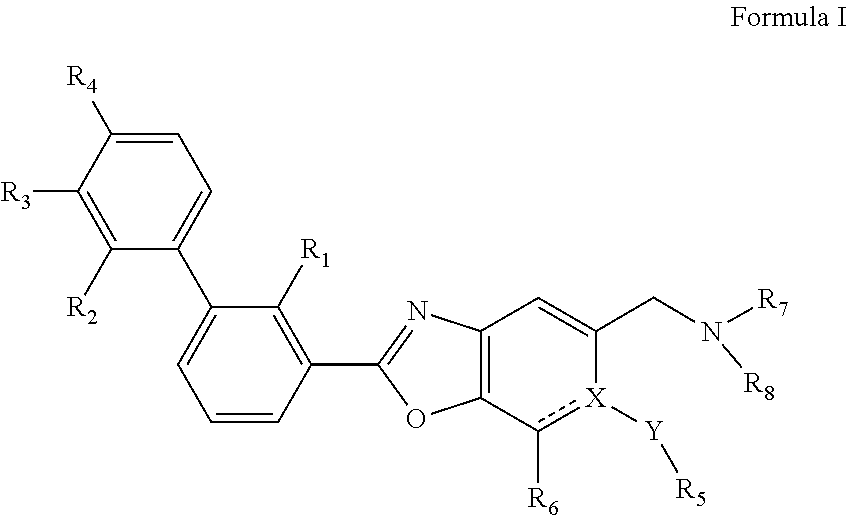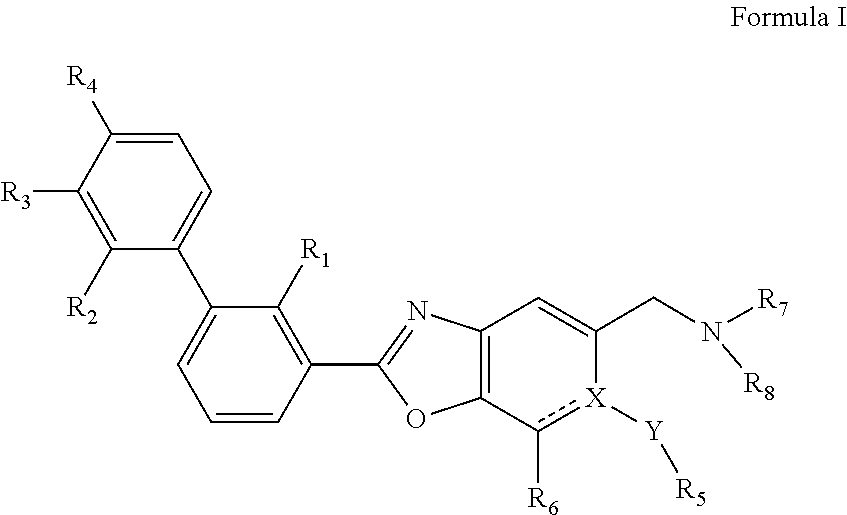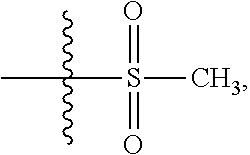Immunomodulators, compositions and methods there of
a technology of immunomodulators and compositions, applied in the field of pharmaceutical active compounds, can solve the problems of small molecule inhibitors that directly target pd-1 or pd-l1 that are still not approved
- Summary
- Abstract
- Description
- Claims
- Application Information
AI Technical Summary
Benefits of technology
Problems solved by technology
Method used
Image
Examples
example 1
Synthesis of Compound 1
(S)-1-((2-(2-methyl-[1,1′-biphenyl]-3-yl)-6-(methylthio)benzo[d]oxazol-5-yl)methyl)piperidine-2-carboxylic acid
[0199]
Step 1: Preparation of methyl 4-hydroxy-2-(methylthio)-5-nitrobenzoate
[0200]
[0201]Methyl 2-fluoro-4-hydroxybenzoate (20.00 g) was dissolved in 200 mL acetic acid, cooled to 0-10° C. in an ice bath, and then concentrated nitric acid (10.1 ml, 0.236 mol) was dissolved in 40 mL acetic acid and slowly added dropwise to the above reaction solution; after the addition, removed the ice bath and naturally raised to room temperature and stirred for 4-6 h. The reaction solution was poured into ice water and quenched. After stirring for 0.5 h, the solid was completely precipitated, filtered, and the filter cake was washed with water 2-3 times, dried, and the crude product was purified by flash chromatography (A.hexane; B.EA; B % from 0-30%, 20 min) gave the product 13.00 g methyl 2-fluoro-4-hydroxy-5-nitrobenzoate as a light yellow solid.
[0202]A mixture of...
example 2
Synthesis of Compound 2
((2-(2-methyl-[1,1′-biphenyl]-3-yl)-6-(methylthio)benzo[d]oxazol-5-yl)methyl)-L-proline
[0215]
[0216]Prepare the Compound 2 essentially as described for Example 1 using the corresponding intermediate. For example, using “L-proline” instead of “(S)-piperidine-2-carboxylic acid” in the last step (step 7) described above.
[0217]Prepare the following examples (shown in Table 1) essentially as described for Example 1 using
instead of
in the step 1 of Example 29, in some examples, using other amide acid, for example L-proline, instead of (S)-piperidine-2-carboxylic acid in the step 7 described above.
TABLE 1PhysicalEXData (MS)No.Chemical NameStructure(M + H)+1(S)-1-((2-(2-methyl-[1,1′-biphenyl]- 3-yl)-6- (methylthio)benzo[d]oxazol-5- yl)methyl)piperidine-2-carboxylic acid473.22((2-(2-methyl-[1,1′-biphenyl]-3-yl)- 6-(methylthio)benzo[d]oxazol-5- yl)methyl)-L-proline459.23((2-(2-methyl-[1,1′-biphenyl]-3-yl)- 6-(methylthio)benzo[d]oxazol-5- yl)methyl)-D-allothreonine463.24((...
example 29
Synthesis of Compound 29
(S)-1-((6-(difluoromethoxy)-2-(2-methyl-[1,1′-biphenyl]-3-yl)benzo[d]oxazol-5-yl)methyl)piperidine-2-carboxylic acid
[0218]
Step 1: Preparation of methyl 2,4-dihydroxy-5-nitrobenzoate
[0219]
[0220]Methyl 2,4-dihydroxybenzoate (850 g, 5.06 mol) was dissolved in a mixture of AcOH (3.6 L) and Ac2O (900 mL). After cooling the clarified solution to 10° C. (ice bath), a mixture of HNO3 (65%) (455 ml) in AcOH (500 mL) was added over 1 h. When the addition was completed, rose the temperature of the mixture solution to 15-20° C. and stirring for another 1 h. Until the raw material was almost finished and the reaction stopped. Poured the reaction solution into H2O (3 L), then the mixture was added for another 30 min without stirring. The precipitate was filtered, rinsed with small amounts of H2O. Then poured the crude product into MeOH (2 L) with stirring. The precipitate was filtered, rinsed with small amounts of MeOH. Dried under vacuum to get the product 480 g methyl 2,...
PUM
| Property | Measurement | Unit |
|---|---|---|
| Immunogenicity | aaaaa | aaaaa |
Abstract
Description
Claims
Application Information
 Login to View More
Login to View More - R&D
- Intellectual Property
- Life Sciences
- Materials
- Tech Scout
- Unparalleled Data Quality
- Higher Quality Content
- 60% Fewer Hallucinations
Browse by: Latest US Patents, China's latest patents, Technical Efficacy Thesaurus, Application Domain, Technology Topic, Popular Technical Reports.
© 2025 PatSnap. All rights reserved.Legal|Privacy policy|Modern Slavery Act Transparency Statement|Sitemap|About US| Contact US: help@patsnap.com



